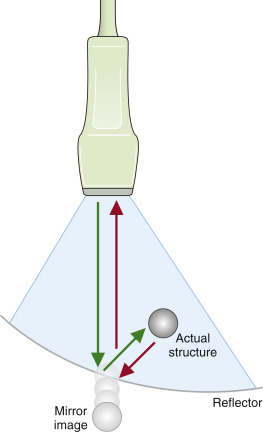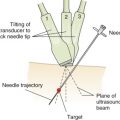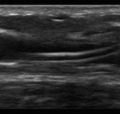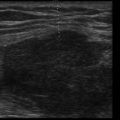Key Points
- •
Artifacts are false images, or parts of images, that do not represent true anatomic structures.
- •
Artifacts arise when one or more properties of sound are violated.
- •
True pathology should be visualized in at least two planes. Suspected pathology that is not seen in multiple planes is most likely an artifact.
Introduction
Artifacts are false images, or parts of images, that do not represent true anatomic structures. Providers should have a basic understanding of the physical principles of ultrasound artifacts to improve acquisition and interpretation of ultrasound images at the bedside. Barring malfunctioning equipment, artifacts originate from erroneous ultrasound signaling that occurs in biologic tissues due to violation of one or more of the following assumptions:
- ▪
Ultrasound echoes returning to the transducer originate from a uniform, single ultrasound beam.
- ▪
Ultrasound waves always travel in a straight path and return after only one reflection.
- ▪
The speed of sound is constant in all types of human tissue (1540 m/s), and the attenuation, or decrease in energy, of ultrasound echoes is uniform.
Artifacts frequently provide insight into tissue makeup and are diagnostic for certain pathologies, such as gallstones and pulmonary edema. Most artifacts can be categorized into one of four categories based on the underlying mechanism: artifacts of wave propagation, beam characteristics, velocity errors, and attenuation. This chapter reviews some of the most common artifacts encountered in point-of-care ultrasound.
Artifacts of Wave Propagation
Reverberation
Reverberation artifact occurs when two or more highly reflective structures are parallel to each other and the ultrasound beam’s path is perpendicular to these highly reflective structures ( Figure 6.1 ). Ultrasound pulses reflect multiple times between the highly reflective structures or between a highly reflective structure and transducer. The ultrasound machine displays these reflections as a series of bright, parallel lines at regular intervals distal to the reflective structure(s) that dissipate in brightness with depth. The ultrasound machine assigns depth to structures based on the time delay of returning echoes. Echoes that return to the transducer after a single reflection are assigned an appropriate fixed depth in contrast to echoes with multiple reflections, which are assigned progressively deeper depths.
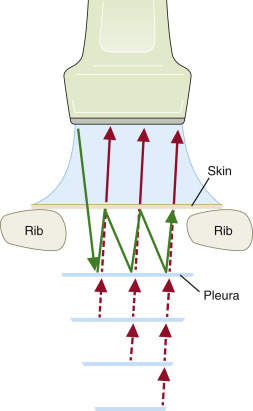
Tissue interfaces where there is a large difference in speed of sound between the two tissues are highly reflective. This measure of resistance to passage of ultrasound waves through a material or tissue is called acoustic impedance . The amount of sound waves reflected at a tissue interface is directly proportional to the difference in acoustic impedance between two adjacent tissues. If there is no difference in acoustic impedance between two different tissues, there will be no reflection of sound waves, but if there is a significant difference in acoustic impedance, there will be reflection of a large proportion of sound waves back to the transducer. Reverberation artifact occurs at tissue interfaces with large differences in acoustic impedance. A classic example of reverberation artifact occurs in the normal lung at the pleural surface, called A-lines ( Figures 6.1 and 6.2 ). This specific reverberation artifact is caused by multiple reflections between the highly reflective pleural surface and skin-transducer interface. Reverberation artifacts can be useful in assessing tissue characteristics, but they can hinder adequate image acquisition of deeper structures.
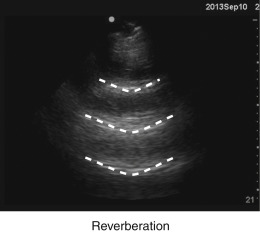
A few techniques can be used to minimize the effects of reverberation artifact. Because reverberation occurs when the ultrasound beam crosses highly reflective structures perpendicularly, adjusting the transducer’s angle of incidence may lessen the presence of reverberation. Similarly, decreasing the distance between the object of interest and ultrasound transducer can reduce reverberation artifact. Tissue harmonic imaging (THI) can reduce artifacts by filtering the fundamental (original) frequencies used. It transmits only twice the original frequency, and it narrows the width of the ultrasound beam. This improves image quality by decreasing artifacts, improving spatial resolution, and increasing penetration.
A particular type of reverberation artifact known as comet-tail artifact is produced when sound waves are reflected between two highly reflective surfaces in very close proximity. Comet tails classically appear as bright vertical lines with a tapering shape. After several reflections, the amplitude of returning echoes is decreased, which is displayed as narrowing of the lines compared to the original echo. This “stacking” of bright horizontal lines spaced very close together with progressively decreasing width creates an image of bright tapering vertical lines ( ![]() ). Comet-tail artifacts can be seen in normal and abnormal lungs and are described in more detail in Chapter 9 .
). Comet-tail artifacts can be seen in normal and abnormal lungs and are described in more detail in Chapter 9 .
Ring-down artifact is similar to comet-tail artifact but is produced by a different mechanism ( Figure 6.3 ). The source of ring-down artifact is a small pocket of fluid trapped by surrounding air bubbles. Ultrasound waves hit a pocket of trapped fluid, the sound waves resonate within the fluid, and a continuous sound wave is transmitted back to the transducer. The resonant vibrations detected by the ultrasound transducer are displayed as bright vertical lines extending deep to the trapped fluid. Ring-down artifact is often used interchangeably with comet-tail artifact, but their origins are quite different.

Mirroring
Mirroring is a type of artifact created by the reflection of a structure from a strong reflector creating a false image behind the reflector ( Figure 6.4 ). Mirroring is similar to reverberation, except reverberation appears as a reflection of tissue interfaces, whereas mirroring appears as reflection of entire organs. The true structure is seen as an image at the actual depth, whereas the artifactual image is seen at a deeper depth, distal to the strong reflector. A mirror image can appear with any strong reflector, most commonly the diaphragm, pericardium, aorta, or bowel. Mirror images of the liver or spleen that appear superior to the diaphragm are easily recognized as artifacts and signify normal lung anatomy above the diaphragm ( Figure 6.5 ). Mirroring across bowel walls in the abdomen can be more challenging to detect.

